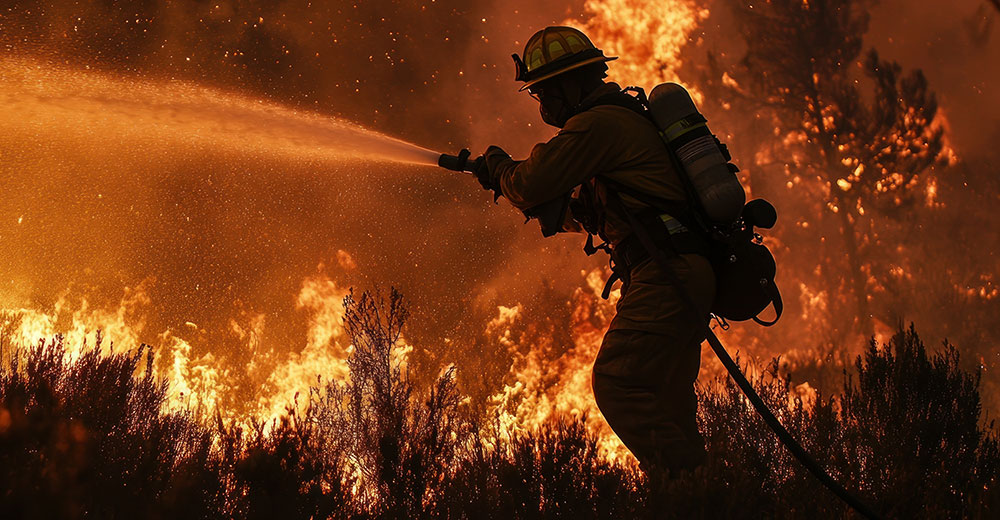Large-scale weather events are becoming increasingly common, and the tendency to build back after a disaster without upgrading the buildings to prevent another one would be foolish. For decades, Los Angeles (L.A.) has had some of the strongest building codes for earthquakes and localized fires, but large-scale fire events are new to the region and appear to be a trend.
Fortunately, there are a variety of technologies and approaches to rebuilding after the fires are put out. Still, aggressive action at the state, county, and city levels will be needed to ensure that policies and rules are updated to provide architects and builders with clear guidance as to what will be allowed for new structures so that this kind of disaster doesn’t repeat itself in the future.
This week, let’s explore strategies like fire-resistant materials, advanced building technologies, and innovative housing solutions to rebuild and adapt for a safer future. Then, we’ll close with my Product of the Week: the Google Pixel Watch 3, which my wife gave me last Christmas.
Hardening Homes Against Wildfires
I grew up in Orange County, Calif., and trained to fight fires. I now live in Bend, Ore., where we tend to have big fires every year.
Last year, my wife asserted that we needed an SUV or trailer big enough to escape a fire should one approach our home. I argued that it would make more sense to harden our house against fire so we could shelter in place because, as we saw in prior fires, and with the L.A. fires, getting out can be problematic given the roads tend to become quickly clogged with evacuating residents and fire teams trying to get in.
Like most homes in the area, our house is primarily constructed of wood and unlikely to survive a fire. We replaced the roof with a combination of insulation and metal. We installed solar panels and Tesla batteries in case of power outages and replaced our siding with fire-resistant Hardie Board, which will smoke if heated but won’t combust.
We are located near a river and have a swim spa, both of which could be used as water sources should the hydrant system become oversubscribed as it did in L.A. We’ve also put in rolling shutters that can further insulate the house from a fire and protect the windows from breaking, which helps prevent fire from entering the home.
Our next step is to install an external home anti-fire sprinkler system that will help keep the house from combusting, given the house is still wood-framed. The service we are looking at is Frontline, which specializes in home wildfire defense.
The cost for this kind of retrofitting is steep. The roof was approximately $20,000, the siding cost around $40,000, the shutters (automatic) were between $2,000 to $5,000 per window, and the Frontline sprinkler system was between $20,000 and $40,000. However, the result is that the structure should now survive external fire events and allow us to shelter in place safely.
As I was finishing this column, my wife shared a link to a story of one of the surviving homes.
Apparently, the homeowner had paid between $100,000 and $150,000 to install his own fire hydrant and rigged a high-performance pump that took over when the pressure dropped in the hydrant system. He saved his house and two others. So, a little foresight resulted in three families not struggling with insurance companies and FEMA and trying to find a place to live in a saturated rental market.
I think the Frontline solution will have the same benefit for me, but this is something to think about.
Redesigning Los Angeles
As of this writing, the issue with the L.A. fires is that the homes were not designed to withstand wildfires. The hydrant system — and this is the problem with most of them — can’t maintain pressure in a wildfire, access was problematic during evacuations, the ability to respond to a fire was too slow, and the winds were near hurricane levels, rendering aircraft mostly useless until the winds dropped.
This last means that current firefighting technology is inadequate to address fires of this magnitude. Like earthquakes, homes need to be built to withstand the fire rather than relying on central firefighting resources to put the fires out.
In addition, the government will have significant revenue problems coupled with substantial increases in spending as it recovers from this damage. Revenues from property taxes will be reduced, and a massive number of people are unlikely to be able to pay even the reduced amount, given that they are now homeless (and possibly jobless). Federal funds won’t be enough to rebuild.
Many of these now-homeless homeowners have lost their fire insurance, and getting insurance on a new, similar structure may be impossible.
These cities need to rebuild fast. They need to build new structures that are far more fire resistant, and they need to rethink many of these areas so that they can be better defended should fires recur, as they likely will.
Rebuilding Fast With Manufactured Homes
One way to rebuild fast is by using approved manufactured homes. I’m not talking typical mobile homes, which are often considered unsafe in high winds and are not particularly fire resistant, but manufactured homes like Blu Homes that are designed like aircraft to withstand a variety of extreme weather events and can be put up on an existing foundation in a matter of hours.
These homes are manufactured mainly with fire-resistant materials and tested to be wind-resistant. Depending on supply, they can be assembled very quickly by relatively small teams of people so that homeowners can get back into their homes rapidly.
Blu Homes packages typically include all fixtures and major appliances installed before shipping, making them ideal for this kind of problem. Prices for a Blu Home range from $285,000 to $635,000 but can exceed this range depending on the number of modules and accessories.
3D Printing Fire-Resistant Homes
This newer technology typically uses a special cement that can be applied through a nozzle to build a home quickly. 3D-printed homes are highly fire resistant if you don’t put a flammable roof on them. They can be built in a few days with a small crew (generally around three to four people) and can be designed to order.
A 3D-printed home typically costs in the range of $30,000 and $100,000, though larger homes can be more expensive than the $150,000 to $450,000 cost of a more traditionally built home.
Often, building codes have to be altered to accept 3D-printed homes, and given how fast they go up, timely inspections in a disaster area can be problematic during the build. However, this technology is likely the fastest method to rebuild with fewer workers. Although the first 3D-printed homes did look pretty strange, later structures combined building methods. This video shows one of the newer designs that looks far more traditional.
Saving money and getting back into a home quickly make this technology nearly ideal, except for one big problem: Few contractors have the needed equipment and training right now. This suggests that a government-funded effort to subsidize training and equipping builders would be timely in L.A. if they want to build back quickly and restore tax revenues.
Wrapping Up: Modernizing Building Codes for Fire Safety
We need to rethink building codes. For instance, this architect specialized in fire-resistant homes, but the city’s requirements resulted in avoidable damage due to outdated building codes.
This effort needs to start with regulatory agencies rethinking building codes to enable more fire-resistant and advanced building methods to address this need. Buildings need to be safe, but regulatory bodies tend to move very slowly when updating codes for fear of litigation should they get it wrong.
Still, unless these governments step up and rethink their codes with regard to these extreme weather events, people are likely to flee their cities as unsafe and unaffordable.
As I write this, utility companies are again being accused of starting some of these recent fires.
Regardless of the cause, a more effective sensor and response network is essential to catch fires while they are still small and containable. This calls for advanced drone firefighting technologies and greater reliance on satellites for early fire detection. Current technology falls short, and we are not utilizing AI, drones, or sensors to their full potential.
We need to build neighborhoods that can better survive events like this, but it starts with cities resetting priorities to reflect the changed world.
One final idea is Arcology, which is a very large structure that can be more easily protected and houses a town or city with living, working, and recreational facilities inside. These would be vastly easier to protect from the increasingly dangerous weather events we anticipate. As our weather degrades, this may be the only viable solution short of migrating to another planet that will reliably keep people safe.
Google Pixel Watch 3
I used to collect mechanical watches but moved to smartwatches some time ago. Normally, I prefer a watch like the TicWatch Pro 5 that has a more traditional look and will use a metal band. However, a metal band can be uncomfortable by either being a bit too big or too small, and it can scratch your ride when cleaning or working on it if you aren’t careful.
Currently priced at $300 (discounted from $349), Google Pixel Watch 3 features a rubber casing and wristband, offering surprising comfort even when worn tightly for heart rate monitoring. It builds in Fitbit functionality for accurate exercise recording, and there is an LTE version for $100 more (which I didn’t get, sadly).
The watch’s screen is up to 2000 nits, which makes it highly usable outside. However, it burns through the battery far faster (two days) than my old TicWatch. Charging is done through a magnetic charger rather than wireless inductive charging, similar to every smartwatch I’ve owned, but not as well as the Apple Watch.
The Google Pixel Watch 3 is particularly useful for competitive runners as it measures your time and distance and compares it to past efforts, pushing you to exceed them. It will integrate with other Google devices like the Nest Camera to see images on the watch or Google TV as the remote control, and it will work as an interface to your phone so you can chat with your watch (not all smartwatches do this).
The watch also has several safety features, including a timer that will trigger an alert if the time you set expires (say you’re on a questionable date or have a sketchy Uber driver) and fall detection that sends alerts if you have a hard fall. You can notify contacts from the watch of your location or let them know you can’t answer because you are already on a call.
You can buy replacement bands for the watch, including metal ones, but I’m fine with the one it came with. The watch is water resistant down to 50 meters. Oh, and you can get up to $300 back if you trade in your old watch (which I didn’t do).
While the Pixel Watch 3 isn’t as feature-rich or has as long battery life as my old TicWatch Pro 5, it is more comfortable, does a better job tracking my sleep and steps, and is easier to use, making it my Product of the Week.




